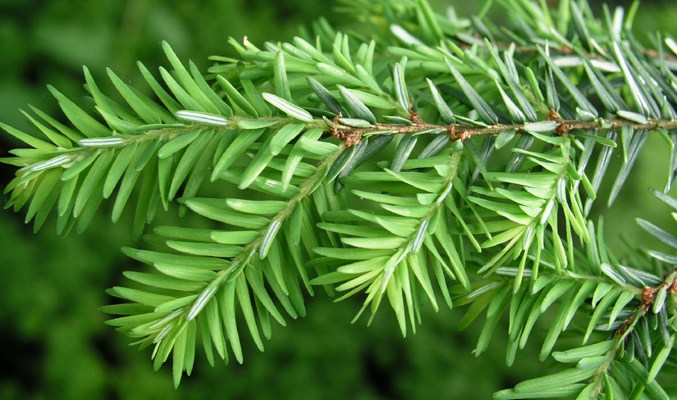|
By Julia Zeh
The Eastern Hemlock (not the poisonous plant commonly known by the legend of the death of Socrates) is a large evergreen tree known for its economic, aesthetic, and ecosystem-related values. The tree is majestic, a staple on the east coast of the US and parts of Canada, and is the state tree of Pennsylvania. These giants can grow to be 160 feet tall with trunks that are 6 or 7 feet in diameter, as they grow slowly over a life that can be up to 1000 years long. But the hemlocks are in danger, and pretty soon there might not be any left. Hemlock that has been infected by the hemlock woolly adelgid (Via United States Department of Agriculture).If you ever happen to find a hemlock tree while outside, look at its branches and the spaces between its leaves. Chances are you’ll probably see some odd looking white fuzzy blobs. These little white things are actually the ovisacs of an insect called the hemlock woolly adelgid, an invasive, aphid-like pest native to Japan which appeared in the US in the 1950s. Over the past six decades the hemlock woolly adelgid has slowly spread, and by 2005 had been reported in parts of 16 states up and down the east coast of the US. When an eastern hemlock is infected, it usually takes about four to ten years before the insects completely overtake and kill the tree, however in some southern areas it can take only three to six years. These tiny creatures don’t look like much, but they’re slowly taking over, bringing down these huge, beautiful trees. When it was assessed in 2011, the eastern hemlock was listed as “near threatened” on the IUCN Red List, meaning the species is declining and approaching becoming endangered. The trees are not well known or particularly exciting to most people (they don’t claim to be the king of the jungle, nor do they make loud roaring sounds), but they’re still incredibly important and deserve our attention. Everyone has heard about endangered rhinos or whales or other large, charismatic creatures, but very few know about the hemlock woolly adelgid’s killing off the hemlock trees, or the invasive emerald ash borer’s impacting the ash trees. Everyone knows about animals like the extinct dodo bird, but it’s a lot harder to find someone who knows about the recently extinct St. Helena olive. Sometimes with all the exciting actions of animals around us, we forget about the plants. But we should remember how incredible these living organisms are; some grow to be far larger and live much longer than we ever will. There tends to be a bias towards animals over plants in protection efforts and studies, and among the general public we sometimes forget that environmental issues don’t just impact large animals, but all of the life on earth. Plants are important too, in fact, we rely on plants in more ways than we realize or appreciate. Plants and specifically trees are foundations for entire ecosystems, and the loss of them impacts ecosystem structure and function. Eastern hemlocks are the homes to many rare species, and without the hemlocks, many species would lose their habitats. The loss of eastern hemlock individuals has already begun to affect transpiration, the loss of water from plant leaves, and as the water cycle changes slightly in these forests, many other organisms feel the effects. The loss of a few of these trees has a domino effect, causing harm to surrounding plants and animals; the hemlock woolly adelgid does not simply affect the trees but the whole ecosystem as well. Just as we need to protect our large, well-known animal species, we also need to protect our endangered photosynthetic friends, the ones who are often forgotten, but on whom we all, big and small, rely.
0 Comments
Leave a Reply. |
Categories
All
Archives
April 2024
|

